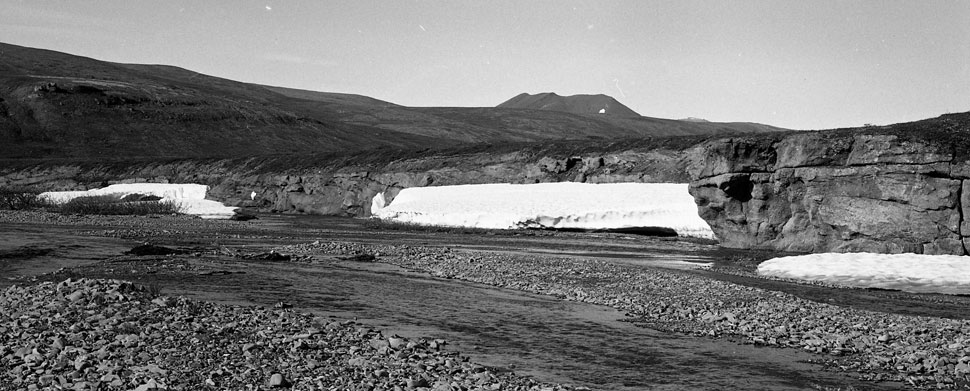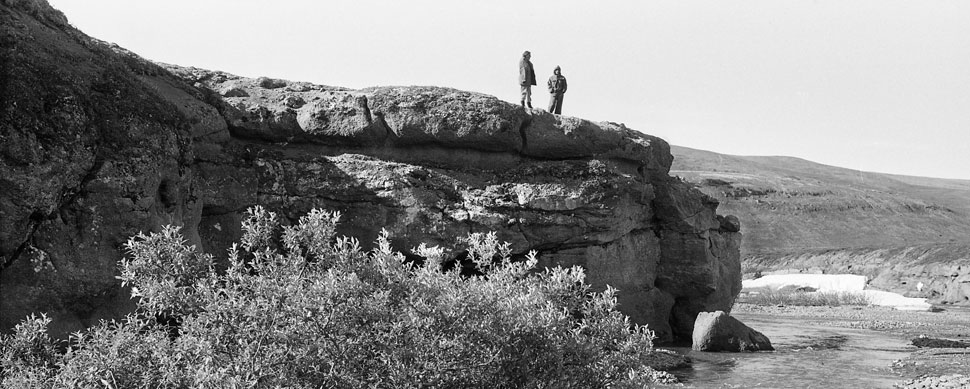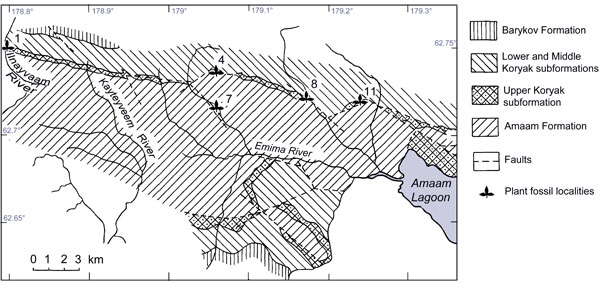Amaam Lagoon
| Koryak Floral Phase | Ugol'naya Bay | NE Russia Map | Fossil Images |
|---|
Lithology and StratigraphyThe deposits of the Barykov, Koryak and Amaam formations (see map to right) are wide-spread on the coast of the Amaam Lagoon, in the basins of the Ilnayvaam and Emima rivers and the upper reaches of the Kayteyveem River. The Barykov Formation here, unlike in the Ugol'naya Bay, contains no plant fossils and is represented mainly by marine terrigenous and volcano-terrigenous deposits with mollusc remains indicative of a Santonian (? Coniacian) - Early Campanian age. The Koryak Formation, 700 - 1000 m thick, conformably overlies the Barykov Formation and can be divided into three parts (see bottom right) (Volobueva and Terekhova, 1974). The lower subformation, 300 - 500 m thick, is composed mainly of volcanimictic and polymictic sandstones, with a subordinate amount of siltstones, tuffstones, and acidic tuffs. These deposits contain abundant ammonites and inoceramids, which indicate the subformation is lower Upper Campanian (Volobueva and Terekhova, 1974) in age. The conformably overlying middle subformation, 300 - 350 m thick, shows an increasing amount of tuffaceous material: it is represented mainly by acid tuffs and tuffites. There are rare marine mollusk remains in these rocks, suggesting that the subformation should be assigned to the upper half of the Upper Campanian and to the lower part of the Maastrichtian. Fossil molluscs found in the Middle Koryak subformation are Inoceramus ex gr. balticus Boehm., Parallelodon sp. indet., Acila sp. indet., Thracia sp. indet., Goniomya sp. indet., Canadoceras newberryanum (Meek), C. kossmati Mat., C. aff. multicostatum Mat., Hypophylloceras sp. indet., Gaudryceras sp. indet. (Volobueva and Terekhova, 1974; Volobueva and Krasnyi, 1979; data by G.P.Terekhova) as well as the Early Maastrichtian Inoceramus pilvoensis Sok., Inoceramus sp. and Patagiosites alaskensis Jones (Herman, 1993b; Pokhialainen, pers. comm. to A.B. Herman, 1990). The Upper Koryak subformation, lying conformably on the middle subformation, is represented by continental deposits: sandstones, tuffstones, tuffites, and siltstones, with interbeds of conglomerates, coaly siltstones, and coals. There are abundant plant fossils in these deposits. The thickness of the upper subformation is 80 - 200 m. The Koryak Formation is overlain conformably, or with a small stratigraphic hiatus, by the Amaam Formation (see right). This formation, about 1500 m thick, is made up of conglomerates, gravelstones, sandstones, and siltstones. |
Map of the Amaam Lagoon area showing positions of plant fossil localities.
Lithology and Stratigraphy of the Cretaceous rocks in the Amaam Lagoon area. |
|
The formation is subdivided into three parts. The lower subformation, 400 - 500 m thick, is considered to be of the Danian - Paleocene age based on mollusc remains of Glycymeris (Glycymeris) amaamensis Volobueva, Crassatella cf. unioides (Stanton), and Turritella aff. pachecoensis Stanton found in these deposits (Volobueva and Krasnyi, 1979), or of the Maastrichtian - Paleocene age according to the data on fossil foraminifers Bathysiphon kushiroensis (Yosh.), B. vitta Nauss, Haplophragmoides kushiroensis Yosh., H. cf. incognatus Martin, Cyclammina akkeshiensis (Yosh.), Silicosigmoilina elegans Ser., Cibicides cf. kiritappuensis Yosh., Gavelinella cf. welleri (Plumm.), Alabamina cf. hokkaidoensis (Yosh.), Eponides cf. tokachiensis Yosh., Lenticulina cf. modesta Bandy, L. cf. davisi (Bandy) found in the same strata in the southeast part of the Amaam Lagoon area (data of M.Y. Serova: Volobueva and Krasnyi, 1979). The youngest deposits of the Amaam Formation are dated as the Late Eocene and, possibly, the earliest Oligocene (Volobueva and Krasnyi, 1979). At the Ugol'naya Bay the Koryak Formation is overlain by the Chukotka Formation, but some researchers (Dundo et al., 1974) do not distinguish the Amaam Formation as a separate unit and suggest that the Chukotka Formation extends to the Amaam Lagoon area as well. In the basal beds of the Chukotka Formation in the Alkatvaam River section (Ugolnaya Bay area), Dundo et al. (1974) found Parallelodon sp. and fragments of an inoceramid prismatic layer, indicative of the Late Cretaceous age of these deposits. The lowermost part of the Amaam and Chukotka formations that overlies the continental deposits of the upper Koryak subformation and contains the Maastrichtian - Paleocene foraminifers and the Cretaceous mollusc remains seems to belong to Korjakia kociubinskii regional inoceramid zone of the terminal Maastrichtian (Pokhialainen, 1994; Pokhialainen, pers. comm., 1994). Therefore, according to ammonite and inoceramid remains found in the middle Koryak subformation and fossil molluscs and foraminifers from the deposits that overlie the plant-bearing beds of the upper Koryak subformation, and if the correlation between the basal parts of the Amaam and Chukotka formations is valid (there are no doubts about this as yet), the Koryak flora is not older than the Middle Maastrichtian and younger than the terminal Maastrichtian. The plant-bearing beds were deposited during the Middle - Late Maastrichtian or, most likely, in the Late Maastrichtian (Herman, 1993b). The Koryak FloraPlant fossils composing the Koryak taphoflora were collected by A. B. Herman in 1987 (jointly with L.B. Golovneva) and 1990 from five localities of the upper Koryak subformation in the Ilnayvaam River basin and in the northern part of the Amaam depression (see map upper right). The close taxonomic similarity of the plant fossils from these localities (Herman, 1993b) permits them to be considered as a single floral assemblage (taphoflora). Resulting fromn a study of these new collections, and of revision of the specimens collected earlier by Terekhova and Volobueva, 32 species have now been identified in the Koryak taphoflora (Moiseeva, 2012). Horsetails are represented by the single species Equisetum arcticum Heer. Ferns are not numerous, neither diverse. Onoclea hesperia R.W. Brown, characteristic of this taphoflora, is rather rare in the localities. Occurrence of Coniopteris tschuktschorum (Kryshtofovich) Samylina is occasional and fragmentary. Remains of Ginkgo ex gr. adiantoides (Unger) Heer are also sparse. Although rather diverse taxonomically, conifers seldom predominate. Most abundant are taxodioid remains of Metasequoia occidentalis (Newberry) Chaney and less frequiently Glyptostrobus nordenskioldii (Heer) R.W. Brown occurs. The collection studied includes seed cones of Metasequoia and an impression of a shoot with Glyptostrobus cones. Impressions of cupressoid vegetative and reproductive shoots are assigned to Mesocyparis beringianus (Golovneva) McIver et Aulenback (this species was originally described by Golovneva (1988) as a type species of a new genus Microconium Golovn.). Pinaceous conifers are not numerous. They are represented by impressions of winged seeds referred to Pityospermum sp. and needles of Pityophyllum ex gr. nordenskioldii (Heer) Nathorst. Seed scales of Pseudolarix arctica Kryshtofovich were also found. Representatives of the Pinaceae may have grown at some distance from the depositional site. Among the conifers of unclear taxonomic affinity is Elatocladus talensis Golovneva. Most of the angiosperms are represented by woody dicotyledons. Angiosperms, especially dicotyledons, are the most taxonomically diverse group in this flora and prevail over the other plant remains. Angiosperms dominant in many localities belong to Corylites beringianus (Krysht.) Moiseeva. This species was originally described as Corylus beringiana (Krysht.) Golovn.: Nessov & Golovneva (1990); Golovneva & Herman (1992) together with several species of Trochodendroides. Among these there are numerous specimens of T. bidentata Vassilevskaya et Golovneva and less abundant are T. lamutensis Golovneva and T. emimensis Golovneva. In the assemblage there are also fossil fruits Nyssidium arcticum (Heer) Iljinskaya associated with Trochodendroides leaves. Ettingshausenia raynoldsii (Newberry) Moiseeva, formerly assigned to the genus Platanus, is also abundant in the Koryak flora. Characteristic species of the Koryak flora are Cissites pekulneensis (Philippova) Moiseeva, C. hermanii Moiseeva, Platimelis platanoides Golovneva, Celastrinites septentrionalis (Kryshtofovich) Golovneva, and Rarytkinia amaamensis Moiseeva. Being usually subordinate in abundance, these taxa persistently occur in most assemblages and, along with dominant species, determine the specific character of the Koryak floristic assemblage. Finds of other angiosperms are not numerous. Liriophyllum cf. aeternum Golovneva and Amaamia tshucotica (Golovneva) Moiseeva are represented by single leaf impressions. Dicotyledons of unclear taxonomic affinity are represented by a sole impression Dicotylophyllum sp. and small fruits Carpolithes biloculatus Golovneva and C. cf. bulbus Golovneva have also been found as single specimens. Monocots are represented by fragmentarily preserved leaves with parallel venation Sparganiophyllum sp. and the presumably semiaquatic herb Haemanthophyllum cordatum Golovneva, which is morphologically comparable with riparian grasses of the families Aponogetonaceae, Alismataceae, and some others. Most of the angiosperm species are characterised by high leaf polymorphism and a broad leaf size range. In many cases, the extreme forms of the morphological spectrum can be easily mistaken for different species and even genera ("macropolymorphic species": Krassilov, 1992). Noteworthy is the general large-leaved habit of many angiosperms, particularly, Trochodendroides bidentata, Ettingshausenia raynoldsii, Corylites beringianus, Platimelis platanoides, Liriophyllum cf. aeternum, and Rarytkinia aamaamensis. The Koryak flora seems to represent typical polar broadleaved deciduous forests rich in angiosperms exhibiting a wide leaf size range (Wolfe, 1987; Herman, 1994; Spicer et al., 1994; Moiseeva, 2012). |
||
 |
 |
| Field photographs taken in 1987 of sections along the Emima River. |


